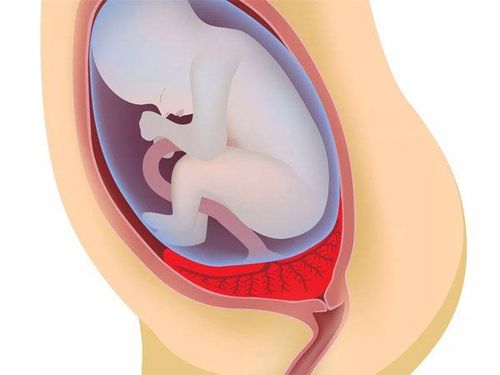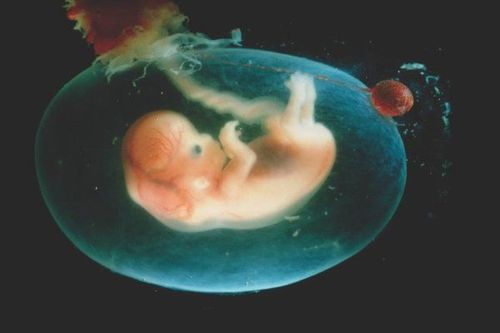This is an automatically translated article.
The article was professionally consulted by Specialist Doctor I Le Hong Lien - Department of Obstetrics and Gynecology - Vinmec Central Park International General Hospital. Doctor Lien has over 10 years of experience as a radiologist in the Department of Ultrasound at the leading hospital in the field of obstetrics and gynecology in the South - Tu Du Hospital.During pregnancy, expectant mothers are often concerned about what to eat and drink to ensure the maintenance of the amount of amniotic fluid for the fetus. However, not many people clearly understand the importance of checking the amniotic fluid index according to gestational age. Let's learn about this parameter in the article below.
1. The role of amniotic fluid in pregnancy
Amniotic fluid appears from the 12th day after conception. Amniotic fluid is made up of: fetus, amniotic membrane and maternal blood. The fetus is surrounded by amniotic fluid. Initially, the amniotic fluid is absorbed by the baby's skin and tissues. At about 20 weeks of pregnancy, the skin begins to change, and fluid is ingested rather than absorbed. Amniotic fluid acts as a buffer to protect the developing baby, cushioning against any bumps or injuries. It also allows for easy movement, promoting muscle and bone growth.Amniotic fluid swallowed by the baby helps to form the digestive tract. Swallowing is an important developmental skill babies practice in utero for many months, to prepare for breastfeeding after birth. The fluid forms urine and maintains a constant temperature for the baby. During labor, amniotic fluid continues to protect the fetus from the trauma of uterine contractions and infection. Amniotic fluid helps to establish the amniotic sac to dilate the mother's cervix. Helps to clear the cervix more smoothly.
2. What is the Amniotic fluid index (AFI)?
Amniotic fluid index, symbol AFI (Amniotic fluid index) is a parameter of the amount of amniotic fluid present in a pregnant woman's abdomen at each stage of fetal development. Amniotic fluid index is measured when pregnant women visit the doctor, based on this index, the doctor will tell the mother whether the amount of amniotic fluid is normal or abnormal.
3. Amniotic fluid index according to gestational age
Normally, as gestational age increases, the amount of amniotic fluid also increases and in the last weeks of pregnancy, the amount of amniotic fluid shows signs of decreasing. The amount of amniotic fluid varies depending on gestational age: at 8-12 weeks pregnant about 50ml, the maximum amniotic fluid volume is about 1000ml at 28 weeks gestation, then it gradually decreases to 900ml at 36 weeks gestation, At 40 weeks gestation. Amniotic fluid is about 600-800ml.There are many cases where mothers have too little or too much amniotic fluid in the abdomen, not commensurate with gestational age. That is, when the fetus is small, the amount of amniotic fluid is too large, and in the last weeks of pregnancy, the amount of amniotic fluid is too little, affecting the delivery of the pregnant woman. These conditions, called polyhydramnios and oligohydramnios, are abnormalities of the amniotic fluid that can pose a risk to pregnancy.
Polyhydramnios: When the amount of amniotic fluid is over 2000ml. Polyhydramnios will make the baby quite mobile in the uterus, so it is easy to cause the umbilical cord to wrap around the neck, abnormal position. Polyhydramnios makes the mother's abdomen distended, causing difficulty breathing, causing uterine contractions and preterm labor, increasing the infant mortality rate. Oliguria or oligohydramnios, amniotic fluid: When the amniotic fluid volume is less than 200ml. If oligohydramnios occurs early in the second trimester, it will greatly affect the development of the fetus. In the third trimester, oligohydramnios is often caused by fetal malnutrition, which can cause compression of the umbilical cord.

Below is a summary table to help you know whether the amniotic fluid index according to your gestational age is normal or abnormal.
| Chỉ số AFI (cm) | Mức độ | Lưu ý |
| < 3cm | Vô ối | Con sẽ gặp nguy hiểm hơn nếu lượng nước ối rất ít dẫn đến tình trạng thiếu ối, vô ối, thai chết lưu hay sinh non. |
| <= 5cm | Thiểu ối | Thiểu ối gây tăng tỷ lệ bị dị tật bẩm sinh, thai nhi phát triển không được khỏe mạnh. |
| 6 – 12cm | Lượng nước ối bình thường | Mẹ bầu có thể yên tâm với chỉ số này. |
| 12 – 25 cm | Dư ối | Dư ối nằm trong chỉ số này vẫn ở trong hạn mức an toàn, do đó mẹ bầu không cần quá lo lắng. |
| >25cm | Đa ối | Các mẹ nên chú ý sẽ có khả năng ảnh hưởng đến thai, các bà mẹ có khả năng bị vỡ ối sớm, túi ối bị căng, sinh non, gây ra tình trạng nhau bong non, ngôi thai đảo lộn dẫn đến bất thường. |
To maintain a stable amount of amniotic fluid throughout pregnancy, not too much or too little, pregnant women need to have a proper diet, rest during pregnancy, drink enough water, have regular antenatal check-ups and check-ups only. Amniotic fluid count according to gestational age to promptly detect abnormalities.
Monitoring amniotic fluid index is necessary to assess the status and health of the fetus. Especially in the last 3 months of pregnancy, the lack of amniotic fluid or polyhydramnios affects the delivery of pregnant women. To protect the health of the mother and baby comprehensively as well as help the mother feel more secure during labor, Vinmec offers a full Maternity service. With this package, the mother will have regular antenatal check-ups and routine tests to monitor her health. The fetus is monitored for fetal heart rate and uterine contractions by obstetric monitor at 37-40 weeks of expected time of delivery. If the baby is born prematurely, they will be cared for and raised with international standards. Premature births are organized in a methodical manner under the coordination of many specialties: obstetrics, anesthesiology, and especially neonatology and paediatrics. This helps to reduce the risks and increase the effectiveness of treatment for health problems that premature babies may have.
Besides, the baby will also be screened after birth to detect diseases early and take appropriate measures. Mothers can be completely assured when using medical services available at Vinmec
Please dial HOTLINE for more information or register for an appointment HERE. Download MyVinmec app to make appointments faster and to manage your bookings easily.














